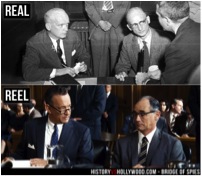What if it’s not your title or age or gender that persuades your people to take on stretch goals? What if it’s not your personality or even your stellar track record? Well, if these aren’t what make things happen, what is? What ignites people to work together to accomplish seemingly impossible outcomes?
Reel Conversations
On a recent rainy day, I saw Bridge of Spies. Tom Hanks portrays real-life insurance lawyer James Donovan who, in 1962, successfully negotiated a spy-prisoner exchange between the US and Russia. I remember watching the nightly news about our pilot Francis Gary Powers and his U2 spy plane. (If you haven’t seen the movie, go now. This is your permission slip. Better yet, ask your boss to take the entire office.)
This real story offers a lesson in leadership: Making things happen begins with a clear commitment. Without any governmental title or clout, and without training in political diplomacy, James Donovan accepted being the negotiator. Why? He didn’t just think that it was a good idea to avoid an international incident that could trigger a war with Russia. He accepted the role because it matched his commitment to serve the greater good.
The negotiation process wasn’t smooth. However, regardless of the roadblocks (“Return our Russian first, then we’ll send you Powers.”), Donovan’s commitment never wavered. His behavior modeled effective leadership.
- He spoke to his Russian counterpart as a person, not as a bureaucrat or enemy.
- He respected the Russian negotiator’s views.
- He managed his emotions.
- He started difficult conversations without knowing how they’d turn out.
- He never felt victimized (they made me do it) by his commitment. He owned it fully.
One of the most telling conversations came when Donovan leans over to his Russian counterpart and says: “We need to have the conversations our governments can’t.” How honest. How risky. How authentic.
No matter how moving these celluloid conversations are, we recognize they are fictional, scripted and rehearsed. Some land on the cutting room floor. When the credits roll, we leave the theatre unencumbered with responsibilities, unaffected by the consequences of the conversations.

Your conversations aren’t fictional. Your customers, boss, teammates aren’t characters. There aren’t rehearsals. You don’t have a cutting room. Your conversations have consequences. They set the stage upon which work with gets done well … or not.
At the most fundamental level, creating a workplace reality of trust and productivity requires honoring your word. Honoring your word is accomplished by doing what you said you would do and by informing others when you see accomplishing the goal is in jeopardy.
Exercise: Anchor What’s Floating
Purpose: Create trust and partnership by telling the truth about what you will and won’t do. Definition: Sometimes a commitment is mushy: “I’ll let you know.” Sometimes a commitment is clear: “You and I will have a one-on-one every other week.” For this exercise, treat both as commitments.
Part 1: Have a conversation with yourself.
- Set aside 15 minutes. Make a list of the commitments you’ve made which do not have a “complete-by” time. (Handwrite the list.)
- Put a name with each commitment. List the names of 5 people with whom you work closely and ask yourself: What does (name) think I’m working on? Or, what is (name) expecting from me?
- Create a separate list of people outside of work.
- Put your name on either list because you also make commitments to you.
Part 2: Have a conversation with the people on your list.
- Schedule a 15-minute conversation with each person. Tell them the purpose is to make sure you are meeting their expectations.
- When you meet: State the purpose. Remember – This is about you meeting your commitments, not about their commitments.
- State each commitment to them. “You asked me for my ideas on the priorities for next year. When do you need them?” Set a by-when and if they say, “Whenever you get to it,” you set a date.
- When you’ve covered your list, ask if you’ve committed to something else. Have a conversation to understand their expectation and negotiate the by-when.
- Thank them, end the meeting and do not bring up any other agenda items.
Part 3: Repeat
If the person wants to meet with you for the purpose of getting current with commitments, congratulations! You’ve created an environment of openness, with no blame and personal responsibility.
Our conversations create realities. It doesn’t take a big budget or a red carpet. It does take effort, and giving up some of our ego.
Subscribe
Get Camille's latest posts!

Camille
Thank you for the article. I will practice the five points Donovan used to manage his emotions.
Enjoy the holiday season.
Barbara Key
Good job!! very clear–perfect for starting out the new year wherever you work..
Keep up the good work, Camille–you are a gift to all who work with you.
My best to you in the new year, Karen